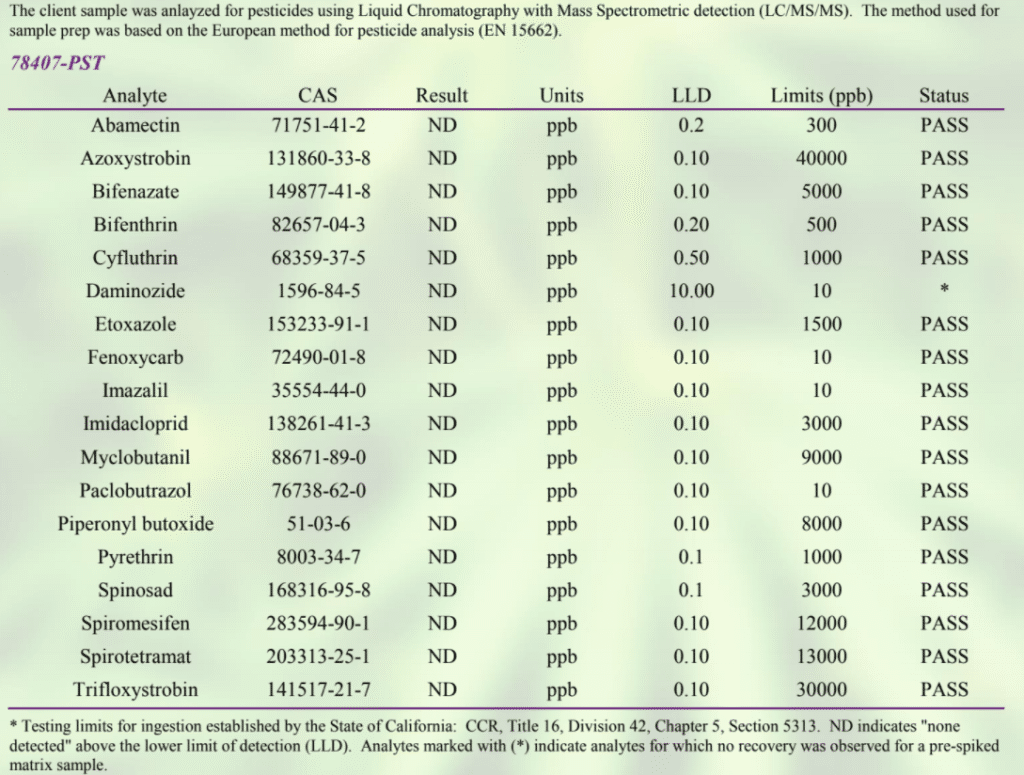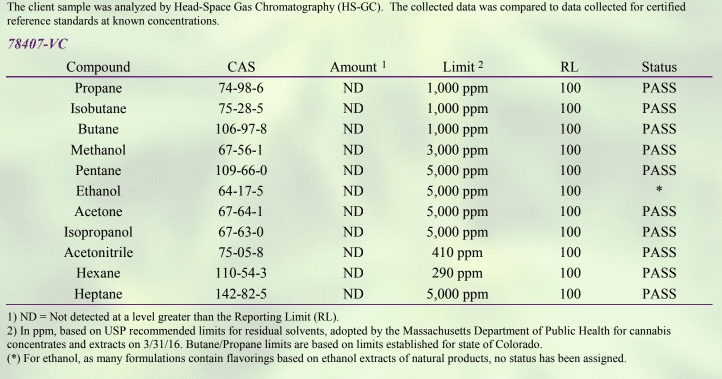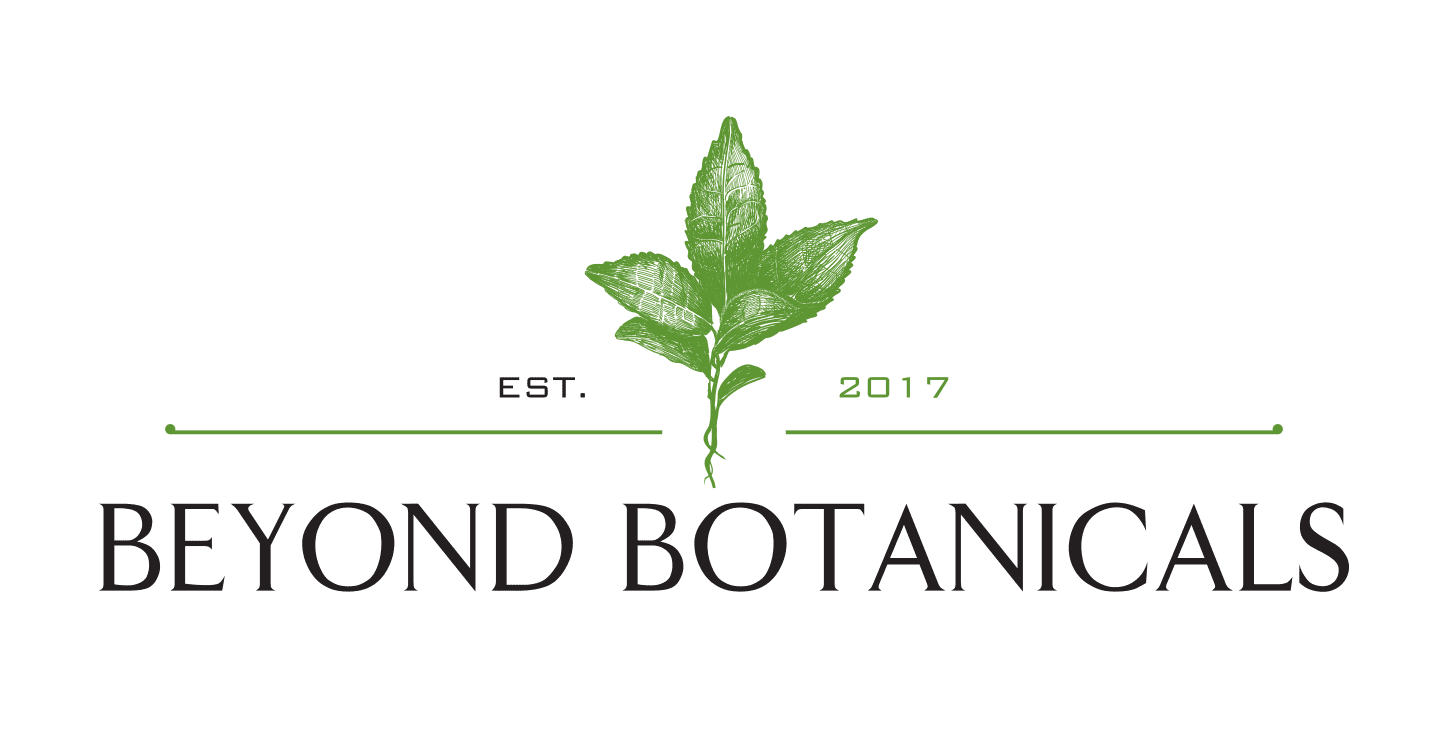The Importance of Certificates of Analysis
There are so many options on the market nowadays that you might be wondering what exactly counts as “good CBD“. The great news is that it’s easy to tell, once you know what a certificate of analysis is, and how to read it. Certificates of analysis are documents that show a laboratory has tested a product for safety, potency, and content.
Read on to learn more about what a laboratory could test for:
Cannabinoid Testing
First a foremost, a laboratory should be testing for cannabinoid concentration. CBD is a cannabinoid, and this test will show exactly how much CBD is in a product. This is the easiest way to tell if what you’re looking at is actually CBD oil, and whether it has as much CBD as advertised. In the image below, you will see that cannabinoids are testing in milligrams per mL, or mg/mL. Each bottle of product you buy should indicate how many milliliters it contains, so you can multiply that number by the mg/mL to find total CBD concentration.

Broadly speaking, the FDA considers anything within 10% of the target number to be accurate and acceptable for use. This means that expecting 100mg of CBD and getting anywhere between 90mg and 110mg is sufficient. This range is in place to account for natural variance in testing equipment and sample preparation procedures. Anything outside of this 10% range should be reviewed to find out why it is not compliant.
Terpenes

Terpenes go along with cannabinoids as naturally occurring compounds in the hemp plant. In a CBD isolate product, you won’t see any of these since they have been removed. However, if you’re looking at a full spectrum product, a good terpene profile is proof that it is full spectrum.
Terpenes also occur naturally in other plants. For example, the peppermint and spearmint oils that we use to flavor our Mint CBD oils contain menthol and eucalyptol. These are the two compounds primarily responsible for giving mint its distinct scent and taste.
Yeast, Mold, Bacteria

The first indicator of a clean product! Testing for the presence of yeast, mold, and bacteria confirms that your product comes from a clean manufacturing process that does not introduce any contamination. This is perhaps the simplest result to interpret. You should see either “Passed”, “ND – for Not Detected”, or similar wording.
Pesticides and Fertilizers

Hemp is a very durable plant and easily grows in many conditions without the assistance of pesticides or fertilizers. Unlike most agricultural products which depend heavily on the use of these chemicals for successful growth, it’s nearly unheard of to need them when growing hemp. As you can see in the certificate above, there are none present, indicated by the “ND” for Not Detected.
As of early 2021, the USDA Organic standards have not been enacted for hemp in all 50 states, which means it may not be possible for a CBD brand to have that seal on their products depending on where they grow their hemp. Until the program is available in all 50 states, this lab test is a great stand-in to prove that the hemp in your product grows to organic standards.
Heavy Metals

When a lab test says Heavy Metals, it’s referring to elements like Lead and Mercury – nasty things that you don’t want to be ingesting large amounts of. The good news is that these generally aren’t just floating around the environment looking for trouble. They’re naturally dense, and they usually settle in wherever they’re introduced to the earth. Most commonly, you can find high concentrations of them in old factories and other run-down buildings.
Although there are some naturally occurring incidences of these metals, the amount that Earth creates is minimal and the FDA has set stringent monitoring and action levels for them. The odds of heavy metals appearing in your CBD oil are pretty low unless the hemp is grown in soil that has been previously contaminated. Chances are, State regulatory bodies would never let that survive for long. In the above certificate, you will again see “ND” indicating no heavy metals are present.
Residual Solvents

There are numerous ways to extract CBD from the hemp plant. The cleanest and one of the most popular is CO2 – or Carbon Dioxide – extraction, which leaves no trace behind. You may also see people refer to it as solvent-free. Solvent extractions use liquids like ethanol or propane to remove CBD from the plant, and can leave harmful residues behind. A residual solvents test will determine whether or not your CBD oil contains these compounds.
In order of cleanliness, CO2 extractions come first, followed by ethanol, and then everything else. If you’re ingesting CBD oil, it should always use CBD created by one of the first two – CO2 or ethanol. The presence of any other solvent on a test is indicative of a contaminated product.
Who should a certificate of analysis come from?
Thanks to the Federal Farm Bill and growing USDA involvement, it is clear that hemp extract products need to be tested by independent laboratories. Essentially, this keeps CBD manufacturers honest. By requiring independent third-party testing, manufacturers are unable to manipulate results to hide shortcomings.
The first red flag of a dishonest CBD provider is that they are only able to furnish their own certificates and nothing from an independent verifier. It’s certainly okay for them to provide their own results alongside third-party results, but you should never accept an in-house test only on its own.
How to recognize a good lab?
Now that we’ve discussed how to identify good CBD oil using the certificate of analysis, you may be wondering how to identify whether or not the lab that provided the certificate is good. There are a few easy things to look for when learning more about the lab.
QR Code

The power of technology can be both a blessing and a curse! Some dishonest actors have gone as far as to digitally manipulate certificates of analysis to change numbers, delete sections, or hide the presence of contaminants.
To combat this, many laboratories have begun placing unique QR codes on each certificate that they generate. By scanning this QR code, you can view the original copy of the certificate, stored securely on the laboratory’s servers. Now, you can compare the copy to the original to confirm that nothing has been changed.
ISO 17025 Certification

The International Organization for Standardization awards this certificate to laboratories that “operate competently and generate valid results, thereby promoting confidence in their work both nationally and around the world”. You can think of it like the final exam a laboratory needs to pass in order to prove that they know what they’re doing. Nearly all states are requiring hemp testing labs to have this certification in order for their results to be valid.
Now that you know more about certificates of analysis and why they are important for CBD products, you can visit our testing library, where we publish the results of all our product tests.
Click here to see Beyond Botanicals Laboratory Tests
Have questions about CBD product testing? We’d be happy to answer them!
